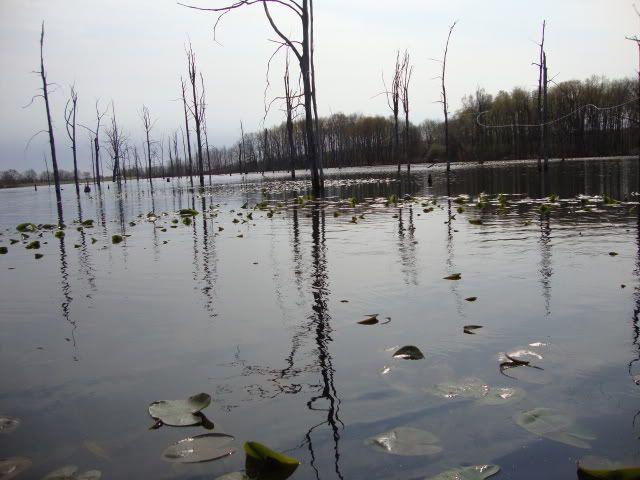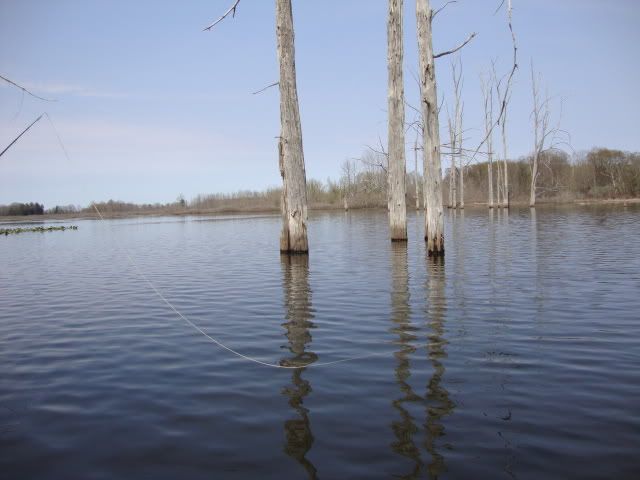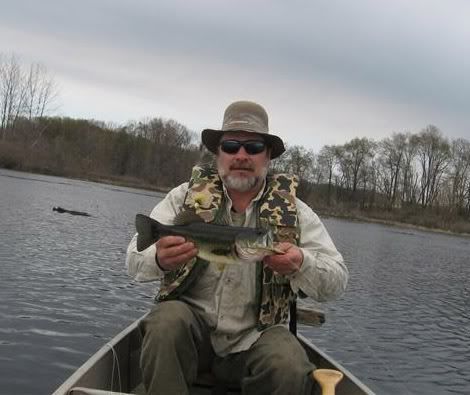After youth turkey hunting with my grandson in the morning I dropped him off home. I was planning on taking him and my granddaughter fishing but my daughter said they had friends coming over for the kids to play with. I ate lunch with them and then headed to do some fishing, alone.
.
….. The wind kicked up when I got out of the van along side the road near Sandy Creek. The sky was moving slow with dark clouds and there was a feeling that rain might drop by later in the day. The early afternoon was still a little chilly but bright, as the sun tried to show itself behind the grayish cloud cover. After waking up early and hunting the morning I didn’t feel like piecing together my 4 piece rods so a put together my 2 piece Scott rod, got my wicker creel basket and headed for the stream.
I crossed the creek and walked up the old railroad grade. Just a little more upstream from where my grandson, Damon, and I fished the first day. I walked through the woods and stepped into the shallow waters along the bank. I fished streamers and a latex caddis as I slowly made it to the area Damon and I fished the week before. The going was slow as well as the catching. I managed landing two trout with a couple of misses. There were a few other vehicles where I parked, and though I didn’t come across many other fishermen, I was sure some already hit the deeper holes I was just fishing.
A few fellows passed by and fished the 3-4 feet of water downstream from me. They nymph fished there way out from the hanging pine branches but never attempted to cast beneath. One fellow pulled a fish from a log jam, on the RR grade side bank, as the other two joined in for a few minutes and tried for more. After that, they climbed the bank and headed for the path and I knew why.
Downstream from that log jam was a wide shallow area of water. Dry boulder tops peaked above the gradual moving water. Riffles and small pocket waters surrounded each boulder or water laden branches. It just wasn’t worth the patience to pick this water apart for what may only contain a trout or two if any. I figure most of the other stream wonderers go to the same log jam, looked downstream at the shallows and climb the bank to the path also. Well, when I got to the log jam I decided to take the challenge and methodically work the shallow stretch.
Second, if I was right, everyone else got to this point and skipped over the shallow stretch also. Therefore the fish, which I was sure there were some, would not be spooked and I would have a good chance hooking into some of these aggressive hungry trout if I fish it correctly.
I tie on a latex caddis to my 7 1/2 foot or so 6x tapered leader. The water is clear but with good placement I could use the riffling water aside the boulders to my advantage. I stay a few feet away from the less used bank which gives me some room behind me for back-casts if need be. Other than that I can maneuver my overhead cast to drop the caddis from upstream, to any downstream fishy location.
….I move with stealth barely kicking up any mud from below my felt bottom boots. I pick my spots and, with down and across stream long casts, I lay the latex caddis just shy of any skinny riffle along any dry top boulder. Keeping my rod tip high, to prevent the line from hanging up on any surface snags, I mend upstream a bit making sure the caddis enters the run first. At times the wind kicks up and a breeze moves upstream so I angle my arm a bit to cast into the wind. The breeze holds up my line, above the water, putting an arc in it. This in turn causes my caddis to flow slower into the thin channeled riffling water giving any shallow holding trout more time to take my offering. I watch my fly line end where it meets the water. Any stoppage or sudden jerk I pull back and set the hook.
A rainbow shoots out of the water with the hook-set. I work the active trout towards me, around hazards and through the shallows. He flips himself out of the water again 10 feet in front of me and returns with a splash. I hold the rod high with my right hand and guide him to my left hand held net.
I slowly work my way through the shallows as if walking on egg shells. My booted feet subconsciously feel for any loose or uncommon obstructions. My casts are of minimal movement, using my wrist more than my forearm, not wanting any sudden movement, by my part, to warn any trout of my intrusion. I pin point my angled cast, dropping the latex caddis between a sunken boulder and a jutting out surfaced rock. I watch as the white caddis sinks within the riffles. My fly line moves with the current a little beyond my sunken caddis. I set the hook and the flash of a rainbow skirts through the back end of the riffling shallows and turns downstream from me. His head surfaces as he sprays water with his tail fin. He splashes his way towards my net.
Stripping and flinching it with my rod tip, I try to coax the palomino to take notice. He wants nothing to do with it but below and further out I catch a glimpse of a long dark fish holding near the bottom. On my next drift through the dark fish starts to follow my bunny leech for a closer look. I try to give the leech more movement with strips and rod tip action as the dark trout follows. Nearer to me I quit all movement and let the leech sink to the bottom for fear the fish will notice my actions before him. I watch as his long body curves downstream and he returns to his lair. I try three more drifts though with only a short glance from the big fish before looking into my fly box for another temptation.
I tie on a heavy white wooly bugger hoping that the weight will drop the bugger down deeper, possibly into a safer feeding zone. After a partial drift I watch the bugger come into view but no sign of the fish. Two more swings and no reactions from beneath.
I contemplate the situation in my mind. The big fish is either curious or hungry. He didn’t get that big by not being cautious. He had time to look my leech pattern over long enough that he must have felt something wasn’t right. The heavy bugger didn’t enthuse him at all so I figured he either seen them before and knew they were danger or didn’t like the bulkiness of it. I look into my bugger box and take out a cone head triple threat. It’s a pattern that the trout may have never seen and with just the sparseness in material and color to give a good minnow imitation.
I tie on the triple threat and cast upstream, across and beyond my target, practically at the nymph fisherman’s boot. I let the triple sink, with an upstream mend, and begin to strip it in quickly, not wanting the big fish to get a good look at it. I see him follow with curiosity but the bugger’s moving too fast for his liking. Again I cast out, this time not as far out. I watch my line and when I think the triple is within his vision, I short whip the rod tip upstream with erratic movement. I strip in line again and again he tries to follow for a closer look. No chance!!
I take a deep breath as my heart races and I watch circular rings form on the water surface from the sporadic rain fall.
I cast once more towards the far side and mend upstream letting the triple drop deep. This time no extra movement or sudden jerks on my part, just a slow bottom drift like a dead minnow. I see the white belly of the triple come into view below the palomino. From out of nowhere I see an oblong fish charge my fly and witness the whiteness of his mouth opening and engulfs my offering. I lift the rod quickly and feel his weight. It feels good!!
The pull on the rod, from below, tugs like a twisting turning branch in fast current. The energy of his head shakes and body jerks are transmitted through the line making the rod tip fluctuate. My line hand finger tips feel every vibration of his aggressive actions. I watch the elongated object as I feel his might. He turns and forcefully swims away as I let tensioned line slip through my finger tips. He wrestles with the line and rod, to free himself, exerting a great amount of energy. Finally, upstream from me, the rod force subdues his escape unexpectedly and again he aggressively tries to release the triple from his jaws with more head jerks. He turns towards me as I can tell he’s tiring quickly from his all-out bursts of energy. In seeing me he turns upstream with a quick bolt but I angle the rod upstream and horizontal making him fight the tip pressure from his side. He turns, this time, downstream and I guide him towards me. My shallow C & R net is too small for his length, I must bring him to the shallows to unhook him. He splashes as he reaches the shallower water than arcs his body towards the more open water. My rod tip is high and he completely turns around as the strength of the rod gives no more leeway to the tiring fish.
On my way through Franklin I stop at Spanky’s Tobacco World and buy $20.00 worth of tobacco supplies. I slide the $4.00+ Fuente cigar out of the cellophane wrapper. The natural tobacco, of the Double Chateau, immediately enhances my sense of smell. I savor the flavor as I wet the natural outer leaf for a smooth slow burn. I lite the cigar and the distinct aroma fills my van as I head for home.
more pics;







































